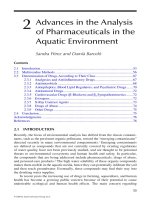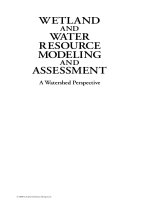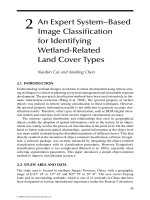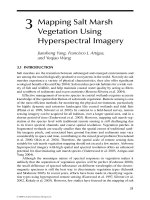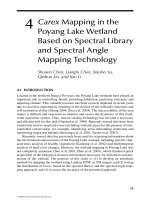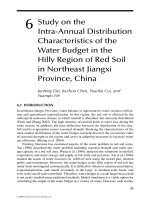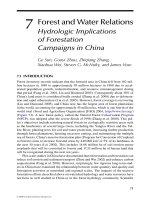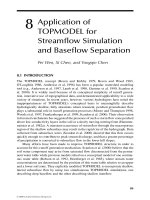WETLAND AND WATER RESOURCE MODELING AND ASSESSMENT: A Watershed Perspective - Chapter 2 doc
Bạn đang xem bản rút gọn của tài liệu. Xem và tải ngay bản đầy đủ của tài liệu tại đây (335.29 KB, 7 trang )
13
2
An Expert System–Based
Image Classification
for Identifying
Wetland-Relat ed
Land Cover Types
Xiaobin Cai and Xiaoling Chen
2.1 INTRODUCTION
Understanding wetland changes in relation to urban development using remote sens-
ing techniques is critical to planning ecosystem management and sustainable regional
development. The per-pixel classication methods have been used extensively in the-
matic information extraction (Wang et al. 2004). The spectral property of surface
objects was utilized in remote sensing classication in these techniques. However,
the spectral property information usually is not sufcient to generate accurate clas-
sication results. Therefore, other types of information, such as DEM (digital eleva-
tion model) and road data, have been used to improve classication accuracy.
The intrinsic spatial distribution and relationships that exist in geographical
objects enable the adoption of spatial information, such as the texture of an object,
which was widely used in the process of classication at the pixel level. On the other
hand, to better represent spatial relationships, spatial information at the object level
was more useful in identifying the distribution patterns of different classes. This idea
directly resulted in the invention of object-oriented classication software. Ecogni-
tion, a software package, was recently enhanced by integrating the object-oriented
classication techniques with its classication procedures. However, Ecognition’s
classication procedure is too complicated (Burnett et al. 2003), especially when
selecting segmentation parameters. This paper introduces a simple object-oriented
method to improve classication accuracy.
2.2 STUDY AREA AND DATA
The study area is located in northern Jiangxi Province, China, with a geographic
range of E115° 24ʹ to 117° 43ʹ and N27° 57ʹ to 29° 47ʹ. The area covers Poyang
Lake and its surrounding wetlands, which is one of 21 wetlands in China that have
been designated as having international importance under the Ramsar Convention.
© 2008 by Taylor & Francis Group, LLC
14 Wetland and Water Resource Mo deling and Assessment
Lushan National Park, one of UNESCO’s world heritage sites, is also located in the
study area.
The image selected is the Landsat ETM+ image taken on October 28, 2004.
The Shuttle Radar Terrain Mission (SRTM)–edited DEM was used as the comple-
mentary data. The SRTM DEM data has the highest resolution among datasets with
a near-global (i.e., between S 56° and N 60°) coverage. It has sufciently detailed
topographic information and can be derived to t the selected image classication.
Figure 2.1 shows the edited SRTM DEM in the study area. As the altitude changes
from high to low, a color gradient from blue to red was used in the legend to represent
corresponding altitude differences. The central part of the image was dominated by
Poyang Lake Plain, shown as blue in the DEM.
2.3 METHODOLOGY AND RESULTS
Normally it is quite difcult to acquire satisfactory classication accuracy because
of the spectral similarity of different objects. By examining spectral characteris-
tics, three groups of objects with spectral similarity were identied: (a) wetland and
grassland/forest, (b) bare land and developing urban area, and (c) built-up area and
muddy beach. Figure 2.2 illustrates the special overlap between the built-up area and
the muddy beach.
To improve the classication accuracy, the road data and DEM (the geographic
information system [GIS] data) were incorporated in the classication process. The
maximum likelihood classication was used to identify initial boundaries of objects,
with the water bodies being extracted and masked from the image. In this process,
the spatial relationships among the classied objects and the GIS data were refer-
enced to develop decision rules in the expert system in order to better distinguish the
spectrally mixed objects.
FIGURE 2.1 The edited SRTM DEM in the study area.
© 2008 by Taylor & Francis Group, LLC
An Expert System –Based Image Classification 15
2.3.1 WATER BODY IDENTIFICATION AND SUPERVISED CLASSIFICATION
Generally, water bodies can be easily identied using the Normalized Difference
Water Index (NDWI) as follows (McFeeters 1996, Gao 1996):
NDWI = (GREEN − NIR)/(GREEN + NIR) (2.1)
where GREEN is the brightness value of the green band and NIR is the brightness
value of the near-infrared band. However, it is still difcult to use the NDWI (Nor-
malized Difference Water Index) to separate the surface waters with plants from the
plants in “wet” lands. To address this problem, the Normalized Difference Vegeta-
tion Index (NDVI), a good indicator of plants, was also calculated.
NDVI = (NIR − RED)/(NIR + RED) (2.2)
where RED is the brightness value of the red band. Then the difference between
NDVI and NDWI was used to detect water bodies more accurately.
Supervised classication was then employed to extract other relevant cover informa-
tion from the image by masking out the water bodies. Seven land cover types, includ-
ing built-up area, wetland (with vegetation), grassland, forest, bare land, muddy
beach, and farmland were identied.
2.3.2 EXPERT KNOWLEDGE
According to spectral analysis of these land covers, the muddy beach is easily con-
fused with the built-up area, while muddy beaches usually distribute along water
FIGURE 2.2 The spectral comparison of the built-up urban area with the muddy beach.
© 2008 by Taylor & Francis Group, LLC
16 Wetland and Water Resource Modeling and Assessment
bodies and built-up areas are close to roads and rails. Thus, the spatial adjacency of
these two objects to water bodies, the province-level roads, and railways were mea-
sured on the relevant thematic map, and were then incorporated in the expert system.
Spectrally, the wetland (with vegetation) is similar to the forest and the grassland.
However, wetlands are usually located adjacent to waters or muddy beaches, with
their elevations lower than surrounding forests and grasslands. The normal water level
of Poyang Lake uctuates between 5.9 m and 22.20 m seasonally and the height of
the hygrophyte inhabiting the area ranges from 13 m to 16 m (Tan 2002). Therefore,
the neighborhood relationship and the wetland classication unit’s mean elevation
were used as criteria in the expert system. As the spectral property of the developing
urban area is similar to bare land, it was not classied as an individual land cover type
in the initial supervised classication. Usually the developing urban area has more
stable relationships with roads and existing urban areas than bare land; this fact was
used as the decision rule in the classication to distinguish the two types of classes.
Figure 2.3 shows the classied results. In the left picture the red part is the developing
areas while the existing urban areas and roads were depicted as blue or green lines.
The result accords well with the color features on the original ETM+ image.
2.3.3 OBJECT NEIGHBORHOOD SEARCH AND DEM ANALYSIS
To acquire the spatial neighborhood relationship at an object level, a clump procedure
was performed on the image with ERDAS Imagine. The results included an object
ID image, where the pixel value stands for its object ID code. A search was applied
to the reference object images, which included a water object image and a road object
image at the pixel level, to produce a new neighborhood relationship image. Then the
neighborhood ID image was obtained with an overlay of the object ID image and the
neighborhood relationship image, where the LUT (look up table) was achieved. A
new LUT, including only the pixels with a value larger than zero, was produced by
sieving the LUT using the histogram of the neighborhood ID image. The new LUT
was loaded into the object ID image to produce a neighborhood object image. With
FIGURE 2.3 The identied developing urban area (in the left image, the lighter area is
the developing urban area identied; the right image is the Landsat ETM+ RGB image with
Bands 4, 3, and 2). (See color insert after p. 162.)
© 2008 by Taylor & Francis Group, LLC
An Expert System –B ased Image Classification 17
the expert knowledge analysis described in section 2.3.2, ve object-level search
images were created through object neighborhood searching. To obtain the altitude
property of each classied object, the overlay analysis was utilized between the
clump result of the supervised classication and the edited SRTM DEM data, which
generated the mean elevation of each classied object.
2.3.4 CONSTRUCTIONOFTHE EXPERT SYSTEM
The expert system was constructed with the ERDAS Imagine’s Knowledge Engi-
neering function, where the prospective class was used as a hypothesis, the deter-
mination criterion as a rule, and the parameter as a variable. In the experiment, the
supervised classication result, the ve object-level search images, and the mean
elevation in every object clump were induced as the variables. The criteria were
expressed as the following rules:
If (muddy-ser = T and (sc = g or sc = fr) and men-elv ≤ 20) nalc = wt;
If (muddy-ser = T and sc = u and (rod-ser = T or ral-ser = T or urb-ser = T)
and wat-ser = T) nalc = m;
If (muddy-ser = T and sc = u and (rod-ser = T or ral-ser = T or urb-ser = T)
and wat-ser = T) nalc = fm;
If (sc = bl and (rod-ser = T or ral-ser = T or urb-ser = T)) nalc = dv;
Else nalc = sc.
where muddy-ser denotes the muddy beach object-searching image, rod-ser the pro-
vincial road object-searching image, and ral-ser the railway object-searching image.
T represents the object that was located in the searching threshold; the nalc means
the nal expert system classication result, and sc is the supervised classication
result. Grassland is denoted by g, forest fr, wetland wt, muddy beach m, built-up
urban areas u, farmland fm, bare land bl and developing urban area dv.
A classied result based on the expert system was obtained, and the comparison
between the expert system classication result and the supervised classication
results are shown in Figures 2.4 and 2.5. The pictures illustrate that some errors
generated by the per-pixel classication were corrected by the expert system–based
classication. For example, the previously misclassifed built-up areas were corrected
to the muddy beaches and the previously missing developing urban areas near Nan-
chang City were detected by the new method.
2.4 CONCLUSION
The rule-based expert system approach could improve the classication of wetland-
related objects that have similar spectral characteristics. The object-level spatial
searching method, which was incorporated with supervised classication results and
the road and elevation information, proved to be effective for deriving a set of object
spatial searching images.
© 2008 by Taylor & Francis Group, LLC
18 Wetland and Water Resource M odeling and Assessment
ACKNOWLEDGMENTS
This study was funded by the 973 Program (2003CB415205) of the Chinese Natural
Science Foundation and the Open Fund project (200401006(1) of the Key Lab of
Poyang Lake Ecological Environment and Resource Development of Chinese Min-
istry of Education housed in Jiangxi Normal University.
REFERENCES
Burnett, Charles, Kiira Aaviksoo, and Stefan Lang. 2003. An object-based methodology of
mapping mires using high resolution imagery. Paper presented at Ecohydrological Pro-
cesses in Northern Wetlands Tallinn. Estonia: Tartu University Press.
Gao, B. 1996. NDWI—a normalized difference water index for remote sensing of vegetation
liquid water from space. Remote Sensing of Environment 58:257–266.
McFeeters, S. K. 1996. The use of the Normalized Difference Water Index (NDWI) in
the delineation of open water features. International Journal of Remote Sensing
17:1425–1432.
Water
Built-up Urban
Welland
Mud Beach
Forest
Grassland
Bare Land
Farmland
Developing Urban Area
(
a
)(
b
)
FIGURE 2.4 The overall comparison between the per-pixel classication (a) and the expert
system–based classication (b). (See color insert after p. 162.)
FIGURE 2.5 The comparison for the Poyang Lake area with the two classication meth-
ods (the left image is the per-pixel classication result, the middle one the original Landsat
ETM+ image, and the right the expert system–based classication result). (See color insert
after p. 162.)
© 2008 by Taylor & Francis Group, LLC
An Expert System –Based Image Classification 19
Tan, Qulin. 2002. Study on remote sensing change detection and its application to Poyang
international importance wetland. Ph.D. dissertation, Institute of Remote Sensing
Applications, Chinese Academy of Sciences, 48–49.
Wang, Zivu, Wenxia Wei, Shuhe Zhao, and Xiuwan Chen. 2004. Object-oriented classica-
tion and application in land use classication using SPOT-5 PAN imagery. Geoscience
and Remote Sensing Symposium, IGARSS ’04 Proceedings, Vol. 5, 3158–3160.
© 2008 by Taylor & Francis Group, LLC

